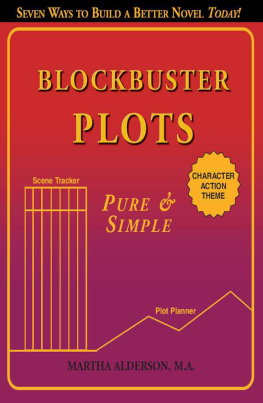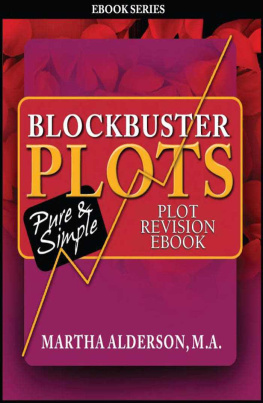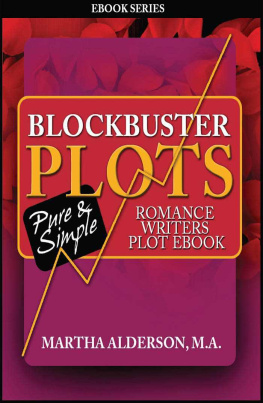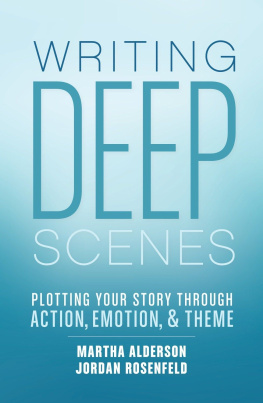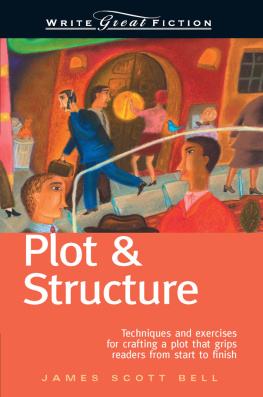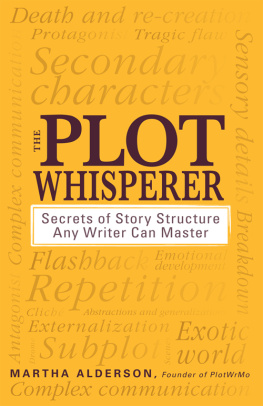Contents
Guide
Writing Blockbuster Plots
A Step-by-Step Guide to Mastering Plot, Structure, and Scene
Martha Alderson
Cincinnati, Ohio
WRITING BLOCKBUSTER PLOTS. Copyright 2016 by Martha Alderson. Manufactured in the United States of America. All rights reserved. No part of this book may be reproduced in any form or by any electronic or mechanical means including information storage and retrieval systems without permission in writing from the publisher, except by a reviewer, who may quote brief passages in a review. Published by Writers Digest Books, an imprint of F+W Media, Inc., 10151 Carver Road, Suite # 200, Blue Ash, OH 45242. (800) 289-0963. First edition.
For more resources for writers, visit www.writersdigest.com/books .
Distributed in Canada by Fraser Direct
100 Armstrong Avenue
Georgetown, Ontario, Canada L7G 5S4
Tel: (905) 877-4411
Distributed in the U.K. and Europe by F&W Media International
Brunel House, Newton Abbot, Devon, TQ12 4PU, England
Tel: (+44) 1626-323200, Fax: (+44) 1626-323319
E-mail:
Distributed in Australia by Capricorn Link
P.O. Box 704, Windsor, NSW 2756 Australia
Tel: (02) 4577-3555
Acknowledgments
I owe a big debt of gratitude to all of the writers that openly shared their need, and often desperation for and resistance to, plot and structure and scene. I may never have self-published the original Blockbuster Plots if not for them, which would never have led to The Plot Whisper and best-selling author status. I know for a fact that A Spiritual Guide for Writers: Secrets of Personal Transformation would have remained hidden and unrealized.
I continue to give thanks to Teresa LeYung Ryan and Luisa Adams for their love, generosity, and belief in me. Added gratitude goes to Luisa for her gentle and nurturing nature and a shared belief in the healing power of spirit.
Thanks also to the following:
Melanie Rigney for being the first person to believe in my approach to teaching writers how to plot, and for believing in me. Thank you for your encouragement when I needed it most.
Phil Sexton for his patience and his offer to breathe freshness into the original Blockbuster Plots, which has sent me on a twelve-year journey into the heart of stories, writers, and me.
Rachel Randall for taming what often felt like chaos, editing with a brilliant eye for detail, and caring for and vastly improving Blockbuster Plots. Cris Freese for seamlessly stepping in with his support.
Writers Digest for their endorsement from the very beginning. Thank you for finding merit in my work as early as 2003.
There are many to thank in the intervening years between the first Blockbuster Plots and what Writing Blockbuster Plots is today, including the University of Santa Cruz Extension, the California Writers Club, Brian Parker, various writers groups, the San Francisco Writing Conference, Jill Corcoran, Adams Media, Peter Archer, Paula Munier, and Jordan Rosenfeld.
I am forever grateful to my husband, Bobby Ray Alderson, for his love and protection, for never letting up on me to finish as I labored to bring my original vision of Blockbuster Plots into form, and for his constant and passionate belief in me.
Introduction to the Revised Edition
Before self-publishing Blockbuster Plots: Pure & Simple (BBP) in 2003, I searched the index of every popular writing book I could get my hands on. If I did find mention of plot, I never found more than a single chapter. At that time, the focus of these books was on writing for discovery. Plot and structure constricted the channels for creativity and stifled inspiration. I found the opposite to be true with my students: Structure doesnt kill creativity. Rather, developing fixed boundaries enables creativity, sparking innovation and freeing the mind of the tension of aimless wandering. Since then there has been an explosion of books on plot. Currently, plot is mentioned, discussed, and taught in every writing circle, for every genre, and using a variety of approaches.
Now its time to go back to the basics. Early on, I found that writers instinctively know that they can immediately improve their stories with a command of plot, structure, and scene. Falling back on a commonly recognized mantra for writers (and my experience in special education), I strived to show plot, structure, and the essential elements of scene with the help of two visual templates I developed, the Plot Planner and Scene Tracker, instead of telling or lecturing on these elusive elements. But as much as some writers wanted help, they were also resistant and fearful of organized, linear templates. Even when some writers fought back, I persisted. I wanted writers to experience the freedom of structureI saw that ah-ha moment flash across too many writers faces. These writers benefited from facing their fears, trying new techniques, and finding solutions to problems in their writing that they didnt know existed. I encouraged writers to lean on plot, structure, and scene concepts because I received e-mails and handwritten letters from other writers, expressing their thanks.
The longer I taught plot to writers, the more stories, memoirs, and screenplays I analyzed for common, universal elements of plot, structure, and scene. At the same time, I gained insight into writers inner worlds of creativity. From this exploration and insight, I developed self-produced plot workshop DVDs (now online video programs), the Plot Whisperer blog, and The Plot Whisperer, my first traditionally published book. In The Plot Whisperer, I introduced the idea of the Universal Storya concept of birth, growth, death, and renewal that exists at the core of every narrative (and of life itself). That turned me into a best-selling author.
Throughout the years, as writing trends shift and as I delve deeper into the secrets of change and transformation based on the Universal Story, Ive stayed true to every single idea in Writing Blockbuster Plots. But Ive also expanded on my original ideas, always returning to the two templates I offer here: the Plot Planner and the Scene Tracker. These visual representations of plot and scene remain at the core of my work. They even translate to transformation for writers and people interested in living a more fulfilling life.
Martha Alderson
Santa Cruz, California
September 2015
Introduction
Are you confused about plot? You are not alone. Plot took me years to pin down. I attended all sorts of writing workshops but found much of the information difficult to transfer to the page. I read all sorts of books on the craft of writing, but the advice generally boiled down to putting your character in a pickle and seeing what happens next. This technique works for many successful writers, but it did not work for me.
I longed for something more concretenot a formula per se, but specific guidelines to help bring depth to my storylines. I searched for anything I could find that directly addressed the issue of plot development. Unable to find what I sought, I berated myself for not grasping what everyone else seemed to understand naturally. I even quit writing for a spell, reasoning that if I were truly meant to be a writer, it would come more easily for me. But the muse continued to haunt me. Over time, I came to realize that everyone else was struggling with plot; they just were not talking about it.


